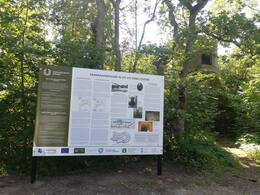Apie Stebelio baterijos konstrukciją
Baterijos gamyba buvo labai brangi.
Tam buvo skirta 20 milijonų rublių. Objekto lubos buvo padengtos 3,5 metro betono sluoksniu, kuris buvo pilamas viena eile: Komandos posto statyba truko keturias naktis ir dienas, o kiekvieno bokšto liejimas – dešimt dienų. Baterijai statyti iš Maskvos buvo atgabenti du milžiniški DEMAG kranai. Betono liejimui reikalingi skaldos akmenys buvo perkami iš vietos gyventojų ir apmokami cariniais aukso rubliais, nes niekas nenorėjo gauti rusiškų pinigų. Baterijos statyba buvo nepaprastai brangi. Tam buvo skirta 20 milijonų rublių. Objekto lubos buvo padengtos 3,5 metro betono sluoksniu, kuris buvo pilamas viena eile: Komandos posto statyba truko keturias naktis ir dienas, o kiekvieno bokšto liejimas – dešimt dienų. Baterijai statyti iš Maskvos buvo atgabenti du milžiniški DEMAG kranai. Betono liejimui reikalingi skaldos akmenys buvo perkami iš vietos gyventojų ir apmokami cariniais aukso rubliais, nes niekas nenorėjo gauti rusiškų pinigų.
„Istorijos iš Spuro kojos pabaigos“, sudarytoja Bruno Pao, Kuresarė, 2004 m.
Susijusios temos
Susijusios vietos
Stebelio pakrantės apsaugos baterijos Nr. 315 vadavietė
Šis pakrantės gynybos baterijos vadovavimo centras yra dabar apleistoje Sääre kaimo dalyje.
Pakrantės gynybos baterija buvo pavadinta jos vado kapitono Aleksandro Stebelio vardu. Statybos prasidėjo 1940 m. gegužę, o baterija buvo baigta prieš pat Antrojo pasaulinio karo pradžią. Baterija atgrasė vokiečių jūrų pėstininkus Lõu įlankoje ir dengė Raudonosios armijos Lõpe-Kaimri gynybos liniją. Artilerija buvo sunaikinta Raudonosios armijos atsitraukimo metu 1941 m. spalį, po to apatiniai barbetų lygiai buvo užlieti. Kompleksą sudarė dvi artilerijos barbetės su dviem 180 mm pabūklais, vadovavimo centras, vėjo malūno formos ugnies valdymo bokštas, generatorius ir katilinė.
Deja, šios intriguojančiai suprojektuotos baterijų pozicijos yra privačioje teritorijoje ir jas sunku rasti. Todėl visiems susidomėjusiems teks tenkintis apžiūra į vadovavimo centrą iš išorės, nes jo apatinis lygis yra apsemtas. Centras buvo nusausintas 2010 m., bet vos po kelių mėnesių vėl prisipildė vandens.





